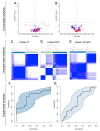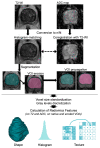Clinical, Technical, and MRI Features Associated with Patients' Outcome at 3 Months and 2 Years following Prostate Artery Embolization: Is There an Added Value of Radiomics?
- PMID: 38248768
- PMCID: PMC10817287
- DOI: 10.3390/jpm14010067
Clinical, Technical, and MRI Features Associated with Patients' Outcome at 3 Months and 2 Years following Prostate Artery Embolization: Is There an Added Value of Radiomics?
Abstract
Our aim was to investigate which features were associated with clinical successes at short- and mid-terms following prostate artery embolization (PAE) for symptomatic benign prostate hypertrophy (BPH). All adults treated by PAE for BPH at our referral center between January 2017 and March 2021, with pre-treatment MRI, technical success, and follow-up at 3 months and 2 years were included in this single-center retrospective study. Radiologists reviewed the prostatic protrusion index (PPI), adenomatous dominant BPH (adBPH), and Wasserman classification on pre-treatment MRI. Radiomics analysis was achieved on the transitional zone on pre-treatment T2-weighted imaging (WI) and ADC, and comprised reproducibility assessment, unsupervised classifications, and supervised radiomics scores obtained with cross-validated Elasticnet regressions. Eighty-eight patients were included (median age: 65 years), with 81.8% clinical successes at 3 months and 60.2% at 2 years. No feature was associated with success at 3 months, except the radiomics score trained on T2-WI and ADC (AUROC = 0.694). Regarding success at 2 years, no radiomics approaches provided significant performances; however, Wasserman type-1 and change in international prostate symptom score (IPSS) at 3 months ≤ -35% were associated with success in multivariable analysis (OR = 5.82, p = 0.0296, and OR = 9.04, p = 0.0002). Thus, while radiomics provided limited interest, Wasserman classification and early IPSS changes appeared predictive of mid-term outcomes.
Keywords: lower urinary tracts symptoms; magnetic resonance imaging; outcome study; prognosis; prostate; prostate artery embolization; radiomics.
Conflict of interest statement
The authors declare no conflicts of interest.
Figures







Similar articles
-
Adenomatous-Dominant Benign Prostatic Hyperplasia (AdBPH) as a Predictor for Clinical Success Following Prostate Artery Embolization: An Age-Matched Case-Control Study.Cardiovasc Intervent Radiol. 2017 May;40(5):682-689. doi: 10.1007/s00270-017-1602-8. Epub 2017 Feb 13. Cardiovasc Intervent Radiol. 2017. PMID: 28194505
-
Influence of benign prostatic hyperplasia patterns detected with MRI on the clinical outcome after prostatic artery embolization.CVIR Endovasc. 2023 Mar 2;6(1):9. doi: 10.1186/s42155-023-00357-y. CVIR Endovasc. 2023. PMID: 36859572 Free PMC article.
-
The STREAM Trial (Prostatic Artery Embolization for the Treatment of Benign Prostatic Hyperplasia) 24-Month Clinical and Radiological Outcomes.Cardiovasc Intervent Radiol. 2021 Mar;44(3):436-442. doi: 10.1007/s00270-020-02702-3. Epub 2020 Nov 18. Cardiovasc Intervent Radiol. 2021. PMID: 33210152
-
Prostatic arterial embolization for the treatment of lower urinary tract symptoms in men with benign prostatic hyperplasia.Cochrane Database Syst Rev. 2020 Dec 19;12(12):CD012867. doi: 10.1002/14651858.CD012867.pub2. Cochrane Database Syst Rev. 2020. Update in: Cochrane Database Syst Rev. 2022 Mar 29;3:CD012867. doi: 10.1002/14651858.CD012867.pub3. PMID: 33368143 Free PMC article. Updated.
-
Clinical predictive factors in prostatic artery embolization for symptomatic benign prostatic hyperplasia: a comprehensive review.Transl Androl Urol. 2020 Aug;9(4):1754-1768. doi: 10.21037/tau-20-437. Transl Androl Urol. 2020. PMID: 32944536 Free PMC article. Review.
Cited by
-
Predicting Early Outcomes of Prostatic Artery Embolization Using n-Butyl Cyanoacrylate Liquid Embolic Agent: A Machine Learning Study.Diagnostics (Basel). 2025 May 28;15(11):1351. doi: 10.3390/diagnostics15111351. Diagnostics (Basel). 2025. PMID: 40506923 Free PMC article.
-
Contrast Agent Dynamics Determine Radiomics Profiles in Oncologic Imaging.Cancers (Basel). 2024 Apr 16;16(8):1519. doi: 10.3390/cancers16081519. Cancers (Basel). 2024. PMID: 38672601 Free PMC article.
-
Commentary on Machine Learning to Predict Prostate Artery Embolization Outcomes? Patient Selection for Prostatic Artery Embolization: Why it Matters.Cardiovasc Intervent Radiol. 2024 Sep;47(9):1255-1256. doi: 10.1007/s00270-024-03838-2. Epub 2024 Aug 19. Cardiovasc Intervent Radiol. 2024. PMID: 39160359 No abstract available.
References
-
- Lebdai S., Chevrot A., Doizi S., Pradère B., Delongchamps N.B., Baumert H., Benchikh A., Della Negra E., Fourmarier M., Gas J., et al. Surgical and interventional management of benign prostatic obstruction: Guidelines from the Committee for Male Voiding Disorders of the French Urology Association. Prog. En Urol. 2021;31:249–265. doi: 10.1016/j.purol.2020.12.006. - DOI - PubMed
-
- Pisco J.M., Bilhim T., Pinheiro L.C., Fernandes L., Pereira J., Costa N.V., Duarte M., Oliveira A.G. Medium- and Long-Term Outcome of Prostate Artery Embolization for Patients with Benign Prostatic Hyperplasia: Results in 630 Patients. J. Vasc. Interv. Radiol. 2016;27:1115–1122. doi: 10.1016/j.jvir.2016.04.001. - DOI - PubMed
-
- Bilhim T., Costa N.V., Torres D., Pinheiro L.C., Spaepen E. Long-Term Outcome of Prostatic Artery Embolization for Patients with Benign Prostatic Hyperplasia: Single-Centre Retrospective Study in 1072 Patients over a 10-Year Period. Cardiovasc. Interv. Radiol. 2022;45:1324–1336. doi: 10.1007/s00270-022-03199-8. - DOI - PubMed
LinkOut - more resources
Full Text Sources

